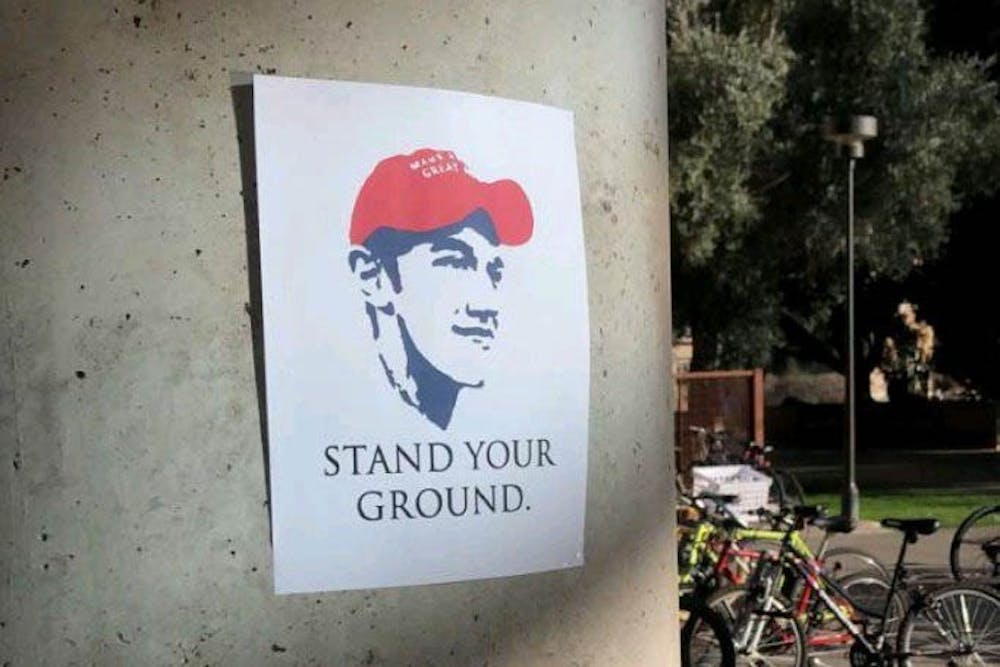Earlier in February, ASU students reported seeing posters in various locations on ASU’s Tempe and downtown Phoenix campuses that some say were intended to intimidate students of color.
While the University was quick to respond with a written statement denouncing the posters and has a team dedicated to handle such incidents, some ASU students of minority communities say they still fear they may be targeted.
ASU said it took down four posters on the two campuses – three in Tempe and one in Phoenix – that featured a drawing of Nick Sandmann, a Covington Catholic High School student who made national headlines after a video of him in a confrontation with Omaha tribe elder Nathan Phillips on Jan. 18 went viral. Underneath the drawing was the phrase “stand your ground.”
And while there were only four posters found, images of them reached thousands on social media.
For some ASU students and faculty, the posters represented an attack on people in minority communities.
After the posters were found on campus, some students approached the Multicultural Solidarity Coalition about “feeling very intimidated and concerned and also fearful for their safety," said Komalpreet Sahota, a second-year graduate student majoring in justice studies and a member of the coalition.
This isn’t the first time controversial fliers have been spotted on campus – other politically charged materials were found in August 2017.
Some students said despite University efforts, ASU students in minority communities feel there aren't enough resources for them to rely on when incidents like this happen.
One resource Sahota said ASU doesn't yet provide is a multicultural center that could serve as a physical respite for students of color, especially for these types of incidents.
“Most universities in the United States have some sort of cultural center for students that houses resource programs ... to provide to marginalized students on campus,” Sahota said. “ASU doesn’t have a center like that, they don’t have those kinds of resources.”
Students and faculty said the latest round of posters were problematic both for using the "stand your ground" phrase and for calling back to a video that can be seen as antagonistic to Native Americans.
“‘Stand your ground’ is a particularly inflammatory statement for a lot of individuals who followed the Trayvon Martin case a few years back,” Sahota said, referring to the Florida law used to defend George Zimmerman after he fatally shot 17-year-old Martin in 2012.
The use of such a phrase was "no accident," said Cheryl Bennett, a professor in the American Indian studies department who specializes in studying hate crimes and violence against Native American people.
"All of these things are kind of connected – the phrases, and the images," Bennett said. "It was no accident that ‘stand your ground' intimidates students of color, people of color, Native people."
She said that the use of Sandmann's image also impacts students.
In the video, Sandmann, who was wearing a “Make America Great Again” hat and attending an anti-abortion rally with his classmates, is seen staring at Phillips, who was singing and beating a drum as a participant in the Indigenous Peoples March.
Although the interaction was initially perceived by viewers nationwide as hostile, conflicting accounts of the incident later bred doubt among viewers as to what took place that day.
But some students and faculty who saw the posters on campus said they felt whoever put up the signs was being immediately clear with their message.
“They’re trying to make a statement and possibly intimidate Native people and people of color,” Bennett said.
Bennett, who is Navajo and Comanche, said that the interaction in the video was antagonistic toward Native people, making the posters’ intentions even clearer. The students surrounding Phillips could be perceived as physically trapping him, she said, and it makes it more likely that people will feel emboldened to do the same to other Native Americans.
The University responded to the posters with a written statement, saying that the posters came from someone outside of ASU and that police were notified of them. ASU also sent out a team of staff to take down the posters.
"Ensuring the safety and security of our students is our top priority, and the University undertakes extensive efforts to ensure student safety is not compromised," the statement said.
Another statement from ASU President Michael Crow deemed the posters "strange notes from strange people."
"At ASU, we see them for what they are: The rantings of unhinged hate-mongers bent on disrupting the lives of people who are moving forward into a future that these Cro-Magnons fear," Crow said in the statement, comparing the people who put up the posters to prehistoric humans.
Members of campus political organizations also joined in the criticism of the posters.
“We do not support propaganda that promotes messaging of white supremacy,” the Young Democrats executive board wrote in a statement. “This propaganda is used to make people of color feel uncomfortable on campus through intimidation.”
While a representative for ASU College Republicans said he didn't want to try to interpret the motive behind the posters, he said that any attempts to scare students of color should be denounced.
“If someone is attempting to make minority students feel fearful, that’s disgusting and it shouldn’t be tolerated on our campus,” said Judah Waxelbaum, a sophomore studying political science and the chairman of the club.
ASU has maintained that the safety of its students is a top priority.
"ASU is a place where open debate can thrive and honest disagreements can be explored, but not when hateful rhetoric is used," the statement from the University said. "That is not who we are.”
Reach the reporter at viraviku@asu.edu and follow @vandana_rav on Twitter.
Like The State Press on Facebook and follow @statepress on Twitter.




